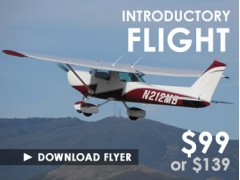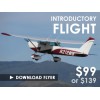Becoming a Student Pilot is the airway to attaining your Private Pilot’s license. Much like learning to drive (but with a 3rd dimension involved), a student pilot will gain knowledge and communication skills and learn the motor-skills that are necessary to operate an airplane safely.
The student pilot process can be divided into three components, or modules. In all, the FAA requires a minimum of 40 hours of flight training to accomplish them. The national average is approximately 68 hours per student; our students average 45-55 hours.
The 3 modules are: Fundamental of Flight, Cross-Country, and Checkride Prep. The Process begins by learning the fundamentals of flight, which is a group of necessary skills that will become the foundation of your operating skill-set.
Your instructor will work with you through the 15 elements to a level of proficiency that prepares you to Solo (be the sole operator/occupant of the aircraft) . Some of those requirements are: proper flight preparation and planning, taxiing, takeoffs and landings, turns, climbs, descents, airspeed control and traffic patterns. Those requirements of FAR §61.87 can be found at: http://rgl.faa.gov/Regulatory_and_Guidance_Library/rgFar.nsf/FARSBySectLookup/61.87
You will also be given a short quiz to evaluate your knowledge base which you have acquired during your lessons. This is technically known as the Aeronautical Knowledge Test. It will cover some Federal Aviation Regulations, airspace rules, flight characteristics and operational limitation of the aircraft you are flying.
once you accomplish your solo flight, you are now eligible to solo within a 25 nautical mile ring from San Luis Obispo Airport.
Solo cross-country flight requirements (FAR §61.93)
The next step in your path to becoming a private pilot is introducing you to other airports in that 25 nautical mile ring; including all the items you must consider when you fly to another airport. Your instructor will provide you with an airport orientation at that airport before you can make solo flights and landing to the airport. You will learn navigation to the airport, their airport operating procedures, and communication requirements.
Following your airport orientation flights we will begin making longer flights to airports beyond 50 nautical miles. We will complete a few ground sessions that focus on use of aeronautical charts for navigation, weather analysis, safe aircraft operation on the ground and in the air involving terrain, other aircraft and weather, control and maneuvering solely by reference to flight instruments and aircraft performance charts.
It is during this period of cross-country and solo flying, that you have completed your Aeronautical Knowledge Written Exam. (FAR §61.105)
once you have completed your cross country requirements, you are almost done with your flight program. It’s time to bring you back to the fundamentals of flight, however this time we are focusing on the performance standards set forth in the Private Pilot Practical Test Standards (PTS).
By the time you schedule your private pilot practical exam you are more than ready demonstrate your flying skill and aeronautical knowledge with your examiner.
Your Private Pilot Practical Test (Flight proficiency. §61.107)
The elements for completing the requirements for your license:
(i) Preflight preparation;
(ii) Preflight procedures;
(iii) Airport operations;
(iv) Takeoffs, landings, and go-arounds;
(v) Performance maneuvers;
(vi) Ground reference maneuvers;
(vii) Navigation;
(viii) Slow flight and stalls;
(ix) Basic instrument maneuvers;
(x) Emergency operations;
(xi) Night operations; and
(xii) Post-flight procedures.
Aeronautical Experience (FAR §61.109)
We know you’re ready, and more importantly, you know you’re ready because you have met and exceeded their requirements.
Log at least 40 hours of flight time that includes at least 20 hours of flight training from an authorized instructor and 10 hours of solo flight
Complete 3 hours of cross-country flight training
Complete 3 hours of night flight training including one cross-country flight of over 100 nautical miles total distance; and 10 takeoffs and 10 landings to a full stop (with each landing involving a flight in the traffic pattern) at an airport.
Complete 3 hours of flight training on the control and maneuvering of an airplane solely by reference to instruments, including straight and level flight, constant airspeed climbs and descents, turns to a heading, recovery from unusual flight attitudes, radio communications, and the use of navigation systems/facilities and radar services appropriate to instrument flight.
Log 10 hours of solo flight time: 5 hours of which are cross-country. Note that one solo cross country flight of 150 nautical miles total distance, with full-stop landings at three points, and one segment of the flight consisting of a straight-line distance of more than 50 nautical miles between the takeoff and landing locations; and three takeoffs and three landings to a full stop (with each landing involving a flight in the traffic pattern) at an airport with an operating control tower.
Tips to keeping you on budget
Chair fly
Take pictures of preflight walk-around, and the panel.
Get a copy of the checklist so you can become familiar with it.
Sit in the airplane when it’s not being used. There is nothing like sitting in the actual airplane when practicing, and it’s free!













